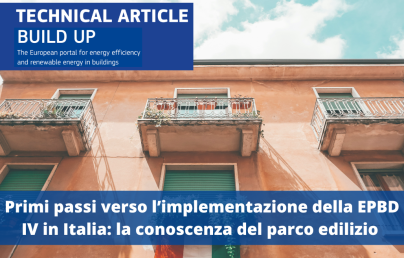
Technical Article - Arise article series ‘Digitalisation in the built environment’ #2: The need for upskilling within the industry

Technical Article - Arise article series ‘Digitalisation in the built environment’ #2: The need for upskilling within the industry
A new approach to train building construction workforce is proposed. This new method could both solve the problem of shortage of workers and to facilitate the digitalisation.
Author: Anna Moreno, International Board Director of buildingSMART and International Affairs Adviser of BiM Institute Italia (IBIMI).

(Note: opinions in the articles are of the authors only and do not necessarily reflect the opinion of the EU).
The building industry is facing many challenges. It is a traditional industry with many traditional workers and professionals with no time to update their competences. Many workers are preparing to retire, and the younger generation is not attracted by the traditional way of working. There are few women approaching this field of work and the built environment needs to reduce its carbon footprint dramatically.
Digitalisation could be the instrument to solve all these problems:
- by improving the quality of workers and professionals working in the building domain to attract the younger generation, including women.
- by facilitating the introduction of new technologies through simulations.
- by designing, constructing, and managing the built environment in a more efficient and effective way.
The ARISE platform has been conceived to certify micro-competences that will help new workers to reach higher levels of knowledge in both digitalisation and innovation in the construction industry little by little based on the concept of ‘growing maturity level’.
Key challenge for the construction sector – addressing the skills shortages
The construction sector faces a significant challenge in addressing skills shortages. This challenge is due to a number of factors, including:
- An ageing workforce: Many skilled workers in the construction industry (1) are approaching retirement age, and there are not enough younger workers to replace them.
- Perceived lack of interest in construction careers: Younger people, and particularly young women, are often not aware of the opportunities available in the construction industry, and therefore do not pursue careers in the sector.
- Lack of investment in training and education: The construction industry has not invested enough in training and education programs to ensure a steady supply of skilled workers in the digitalisation of the building sector. This shortage in workers has acted as a barrier to others to get trained because there has been too much workload for too few workers.
- Competition for skilled workers: The construction sector is competing with other industries for a limited pool of skilled workers, making it difficult to attract and retain talent.
To address these skills shortages, the construction industry needs to focus on attracting younger workers, invest in training and education programs for new workers and importantly also for existing workers in the industry. This can include developing new partnerships with schools, institutes, and universities to provide hands-on training and apprenticeships, as well as offering competitive salaries and benefits to retain skilled workers. Additionally, promoting the construction industry as a rewarding and stable career option can help to increase interest among younger people.
The use of digitalisation with Artificial Intelligence (AI), Internet of the Things (IoT), 3D printing, building automation, simulation, etc. can attract the younger generation more than before. The new scenario provides many new opportunities of jobs with sex equality. By introducing digitalisation into the whole supply chain, more women could enter the building sector, which would begin to address the existing very large gender gap.
Developing new training mechanisms and interactions
The analysis of the existing situation has provided clear evidence that in many countries the directives’ articles concerning qualification and certification of competences of the workforce in the building sector have not been fully implemented. This lack of action adds to the ’performance energy gap’ (2) problem, that is the difference between what has been designed to what has been built and how the buildings perform during their use phase.
Nevertheless, obliging the member states to implement the directives with public registers of designers and installers will not solve the problem of the shortage of skilled workers. The problem is at the foundation of the training system of the building industry. The sector is unique, on one hand it is a very traditional sector, even more so than agriculture, while on the other hand innovation is growing very quickly both due to more attention paid to the carbon footprint of buildings and to the digitalisation that has changed the way to design, realise and manage a building. Besides that, there is the general opinion that building workers are not very open to ‘theoretical studies’ as they are people who prefer ‘hands on’ training.
For all the above reasons, there is the need to change the existing traditional way of training and use a more dynamic method which allows the trainees to choose their own domain and to follow a specific roadmap to increase their own competences. The ARISE platform will support both individual workers/professionals and training centres to reach a growing maturity, step by step. Besides the use of digitalisation, also in the training system are technologies such as Artificial Intelligence (AI) which can facilitate the gains of practical experience in an easy way. This methodology could be more attractive for the younger generation born in the digital era.
Conclusion
The resistance to change is inherent in human beings and it is even more dramatic among the building industry workforces. The advantages of digitalisation have been demonstrated in any other domain and it is now time to be introduced in the building industry. The ARISE platform will support this important change by allowing any professionals and workers to attain the desired maturity level in digitalisation and in the acquisition of new technologies needed to reduce the carbon footprint of the built environment.
References
- Construction Industry Training Board (CITB) CSN Industry Outlook - 2023-2027 Published 18 January 2023
- BIMcert project ‘Mind the Gap’ paper quantification of the gap between energy consumption predicted in the design stage of a building and the actual energy use in actual operation. McCormack Paul published 12 September 2018
-

